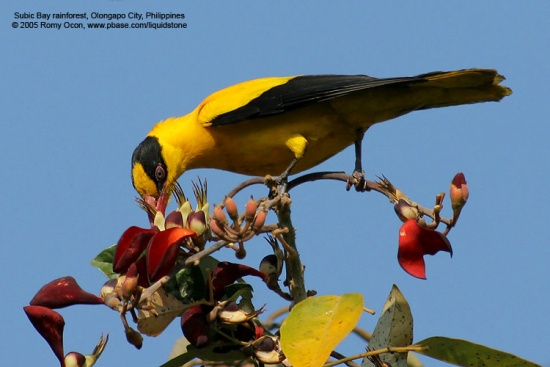- Oriolus chinensis
Identification
27cm
Male
- Bright golden-yellow plumage
- Black mask extending to nape
- Black and yellow wings and tail
- Pink bill
- Grey feet
- Red iris
Female: duller, greenish-yellow mantle.
Juvenile: whitish underparts, blackish streaks on breast, grey bill, lacks nape band.
Distribution
From India east over Indochina to the Philippines, Singapore, Indonesia and eastern China.
Taxonomy
The Slender-billed Oriole was considered to be conspecific but is now widely accepted as full species.
Subspecies[1]
Up to 20 subspecies are accepted:
- O. c. invisus: Southern Vietnam
- O. c. diffusus: Eastern Asia; winters to India, Malaysia and Indochina
- O. c. andamanensis: Andaman Islands
- O. c. macrourus: Nicobar Islands
- O. c. chinensis: Philippine Islands
- O. c. suluensis: Sulu Archipelago
- O. c. melanisticus: Talaud Islands (Karakelong and Salebabu)
- O. c. sanghirensis: Sangihe and Tabuken islands (off northern Sulawesi)
- O. c. formosus: Siau, Tahulandang, Ruang, Biaro and Mayu island (off Sulawesi)
- O. c celebensis: Sulawesi, Bangka, Talisei, Lembeh, Togian Islands, Muna, Butung
- O. c frontalis: Banggai and Sula islands (off Sulawesi)
- O. c oscillans: Tukangbesi Islands (off Sulawesi)
- O. c boneratensis: Tanahjampea, Bonerate, Lalaotoa, Madu and Kayuadi islands
- O. c mundus: Simeulue Island (off Sumatra)
- O. c sipora: Sipura Island (off Sumatra)
- O. c richmondi: Siberut and Pagi islands (off Sumatra)
- O. c insularis: Kangean Islands (Java Sea)
- O. c broderipii: Lesser Sundas (Lombok, Sumba, Sumbawa, Flores, Bisar, Alor)
- O. c maculatus Sumatra, Java, Borneo, Bali, Belitung and Nias islands
Habitat
Coastal woodlands and mangroves, farmland, parks and gardens, to 1600m.
Behaviour
Diet
Omnivorous, figs form a large part of their diet, along with fruit and berries. They also eat large insects, small animals and nestlings.
Breeding
A cup-shaped nest is made from bark, small twigs, grass and roots. The clutch consists of two to three bluish-white eggs with brown spots which are incubated for about 14 days.
References
- Clements, JF. 2008. The Clements Checklist of Birds of the World. 6th ed., with updates to December 2008. Ithaca: Cornell Univ. Press. ISBN 978-0801445019.
- Andamanbirdwatching
Recommended Citation
- BirdForum Opus contributors. (2024) Black-naped Oriole. In: BirdForum, the forum for wild birds and birding. Retrieved 9 May 2024 from https://www.birdforum.net/opus/Black-naped_Oriole






